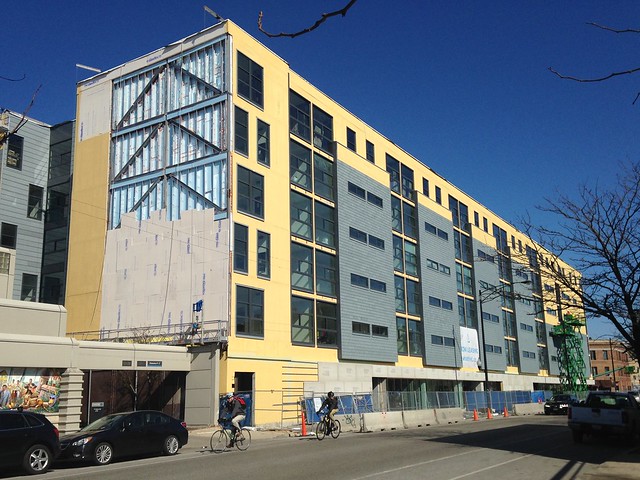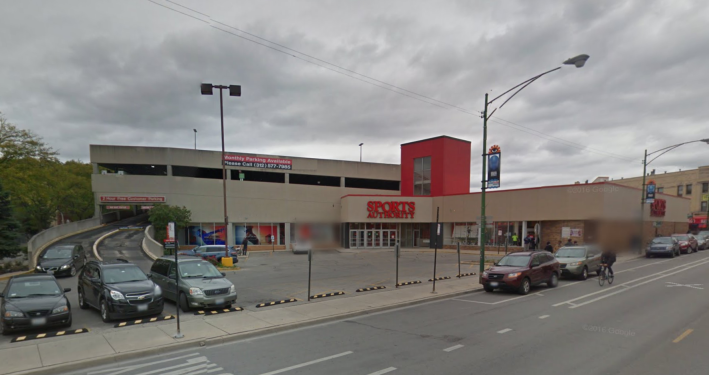
Yesterday the Tribune's Mary Wisniewski further explored a topic Streetsblog's John Greenfield covered two weeks ago for the Reader. Virtually all of Chicago's new transit-oriented development projects are upscale buildings in affluent or gentrifying neighborhoods. TOD advocates argue that adding housing in these communities will take pressure off the rental market. But some Logan Square residents say soon-to-open TOD towers in the neighborhood will encourage other landlords to jack up rents.
The rents at the Twin Towers and "The L" developments near the California Blue Line station will start at $1,400 for a studio. Activist groups like Somos ("We Are") Logan Square and Lifted Voices recently blockaded Milwaukee Avenue in front of the Twin Towers to make the argument that the buildings will speed the pace of gentrification and displacement.
The city's TOD ordinance, first passed in 2013 and beefed up in 2015, has fueled the city's recent building boom by reducing and then eliminating parking requirements for new buildings near rapid transit, as well as allowing for more density. For example, Rob Buono, the developer of the two towers in Logan Square, told John that he probably wouldn't have built the apartments if the ordinance hadn't passed.
The towers are big, conspicuous buildings, so it's understandable that some people blame them for rising rents elsewhere in the neighborhood. But the TOD ordinance and the resulting increase in the number of housing units near the Blue Line aren't to blame for the community's displacement problem. Rather, prior to the ordinance's passage, the number of allowable units near train stations was constrained by politics and growth-inhibiting policy.
TOD experts Wisniewski interviewed said that the trend towards dense housing near stations is a return to sensible pre-1950s city planning. A 2013 study by the Center for Neighborhood Technology found that Chicago actually lags behind peer cities like New York, Philadelphia, Boston and San Francisco when it comes to development near transit. The article also noted that the Chicago Housing Authority demolished 6,000 affordable housing units that were near transit stations.
In recent decades, Chicago zoning rules and politics have ensured that dense development near neighborhood train stations has been relatively rare. Instead, it has mostly occurred downtown, where zoning changes aren’t necessary or are easier to get, and backlash from neighbors is less likely.
In neighborhoods like Logan Square where housing affordability is an issue, there have been dozens, if not hundreds – it's very difficult to track – of expensive new single-family homes with city-required two-car garages built near train stations, the California Blue Line stop.
For example, last year 12 single-family homes were built on the 2600 block of West Medill Avenue, about two blocks northeast of the Twin Towers. Redfin shows that most of these sold for more than $825,000 (the website doesn't have sale prices for all of them).
In the Twin Towers and "The L" ten percent of the apartments will be on-site affordable units, which 1st Ward alder Joe Moreno requires as a matter of policy before approving zoning changes – he doesn't allow developers to take the buyout provision. But those new single-family homes on Medill, and all of the others built in the neighborhood, represent zero affordable housing.
These houses are all near the train station. If TODs had been built on this land instead, there would have been more housing units and fewer parking spots per unit. That would have also meant fewer cars being brought into the neighborhood with each new household.
The politics around neighborhood housing development are hindering projects that would result in new affordable housing. Last year "The L" developer Property Markets Group proposed building a 560-unit rental TOD on a long-vacant parcel near the Hasted Street/UIC stop on Metra's BNSF Line, which required a zoning change.
Currently, if a developer wants a zoning change or a tax incentive, a city ordinance requires them to either include at least 10 percent affordable units or pay into the city's affordable housing fund to help build units elsewhere. But alders can require developers to build more than 10 percent onsite affordable units before approving zoning changes.
25th Ward alder Danny Solis typically requires 21 percent of units in a new development to be affordable before he'll grant a zoning change. Property Markets Group was only willing to provide roughly 90 units -- about 16 percent. So last February Solis turned down their request for a zoning change, adding that he felt the plan called for too many units.
Two months later, PMG announced that they would build a mix of different kinds of housing on the land. They didn't specify the number of units, but the existing B3-2 zoning allows approximately 150 units on the property. Since they don't need a zoning change from Solis to move forward, they're choosing not to include affordable units.
I'd argue argue that Solis' strategy backfired. His demand for 21 percent affordable units resulted in Pilsen getting no new affordable housing. If he had approved PMG's original proposal, the community would have gotten the roughly 90 affordable units that PMG was willing to build.

To help promote affordability and reduce car dependency, alders and community groups should identify land near train stations that's ripe for development and proactively work with developers to create equitable TOD plans.
Right now there's a large parcel in Lakeview that's a likely site for a future TOD. Sports Authority recently declared bankruptcy and announced that that they will sell off a lot of their real estate properties, which could mean that many of their stores will close.
They have a large store and parking garage at the northwest corner of Barry and Clark, a five-minute walk from the Belmont 'L' station. The roughly 63,000 square-foot parcel is zoned B3-3, so it's already TOD-ready and can accommodate several hundred apartments or condos.
The Metropolitan Planning Council's TOD calculator (which I provided some data for) estimates that a residential or mixed-use TOD building here would contribute hundreds of thousands of dollars in property tax and sales tax revenues to the local economy.
While Lakeview is already an affluent neighborhood, rather than a gentrifying one, it's similar to Logan Square in several ways. Housing costs are high, many multi-unit houses have been and are being converted to single-family homes and, as a result, the population has decreased, providing a smaller customer base for local businesses. More TOD can provide many benefits for both of these communities.
![]()
Did you appreciate this post? Consider making a donation through our PublicGood site to help us win a $25,000 challenge grant from the Chicago Community Trust, which will ensure we can continue to publish next year.




